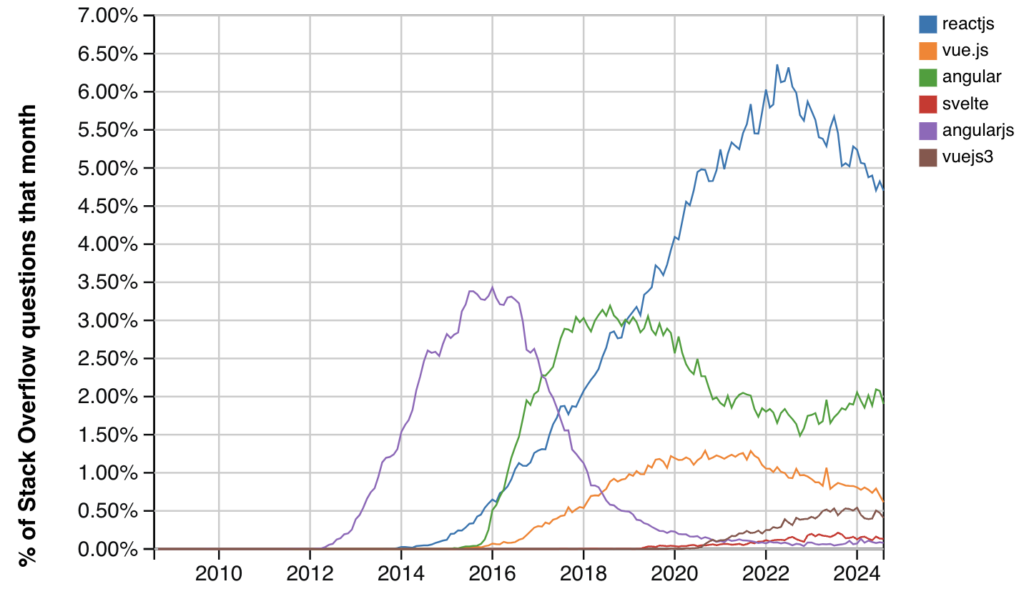In today’s world of modern e-commerce platforms, omnichannel projects, and applications handling millions of transactions per month, choosing the right technology is the foundation for success. JavaScript and its frameworks have taken the market by storm, giving website and online store creators unlimited possibilities for developing interactive solutions. Among these frameworks, Angular, React, and Vue enjoy the greatest popularity. In practice, it’s React that’s most often cited as the technology delivering dynamism, scalability, and flexibility.
What Does React Offer in Terms of Multichannel and Scalability?
Contemporary applications are no longer limited to a simple website—growing demands include integrations with external systems, omnichannel support, and handling large volumes of traffic. React performs excellently in these scenarios because it:
- Enables quick prototyping of new modules in online stores.
- Easily integrates with libraries providing SEO-friendly rendering (e.g., Next.js, Remix).
- Supports a multichannel model, allowing a single codebase to manage various sales channels.
Many developers also value React’s functional approach, which simplifies testing and maintenance for large, multi-layered applications. As a result, they can focus on creating rich interactions and highly efficient user workflows.
Dynamic Features and User-Centered Design
Modern Interaction with the Virtual DOM
React uses a Virtual DOM that significantly reduces operations on the actual DOM tree. This ensures instant reactions to user actions and smooth animations. In e-commerce projects, this translates into:
- Better user experience when applying filters and sorting options in a store.
- Lightning-fast updates to carts, reviews, or recommendations.
- Reduced resource-intensive rendering processes.
Designing the Purchase Journey
Crafting a friendly and personalized “buyer’s journey” is one of the biggest challenges in e-commerce. React offers a wide range of components enabling:
- Integration with payment systems,
- Implementation of filtering and search forms,
- Addition of extensive review modules or blog sections.
When Does React Work Best?
Handling Complex Projects
Brands experiencing rapid growth in product numbers or orders need a tool capable of easy scaling and expansion. React provides a modular architecture that helps maintain code readability and stability over the long term.
Integration with TypeScript
Larger projects increasingly turn to TypeScript. React integrates seamlessly with it, giving developers control over data types and reducing the risk of errors in more complex implementations.
Multitasking and Dynamic Content
React is also a great solution when a platform needs to handle many elements in real time, such as continuously updated inventory levels or live stock quotes.
OxData – An Evolutionary Platform for Crypto and Stock Traders
As part of our DAO Apps initiative, we’re developing OxData, a project designed to support traders in the cryptocurrency and traditional stock market sectors. In these types of applications, the following are critical:
- Real-time data acquisition and visualization,
- Fast response times for chart analysis,
- Dynamic adjustment of the interface to each user’s preferences.
With React, we can create an interface that offers instant refresh of information, attractive charts, and personalized dashboards. This results in more efficient risk management and taking advantage of emerging investment opportunities in real time.
A Broader Context for Framework Usage in E-commerce
Why Does React Win in Many Rankings?
Analyses from portals like BuiltWith or Stack Overflow Trends leave no doubt—React is currently the leader among front-end solutions. This is due to an open ecosystem, easy integration with external libraries, and the unwavering support of the React community.
Angular and Vue versus React
Angular, created by Google, excels in large, long-term corporate projects but is sometimes seen as less flexible for rapid prototyping. Vue, on the other hand, is gaining traction thanks to its accessible documentation and low learning curve, though many companies still prefer React for its “middle-ground” flexibility: it’s easy enough to start with, but robust enough for complex projects.

Among brands using React, you’ll find solutions that handle extremely high traffic, proving the reliability of this library in the most demanding environments.
Summary
React remains a proven and respected choice for projects where dynamic content, flexibility, and scalability are crucial. It’s an ideal fit for the e-commerce landscape and new ventures related to trading or data analysis. Its functional approach, TypeScript compatibility, and growing ecosystem of tools make it a top-tier option for many companies.
If you’re looking for a platform that resolves your integration challenges, withstands heavy loads, and supports creating multipurpose interfaces—React is well worth considering as the foundation for your application. Combined with initiatives like DAO Apps, you can discover real-world implementations where React supports innovative projects and streamlines collaboration among developer communities.
Get in Touch with CodeFormers
We are always ready for cooperation and new challenges. Contact us to learn more about our services, projects, and opportunities.

